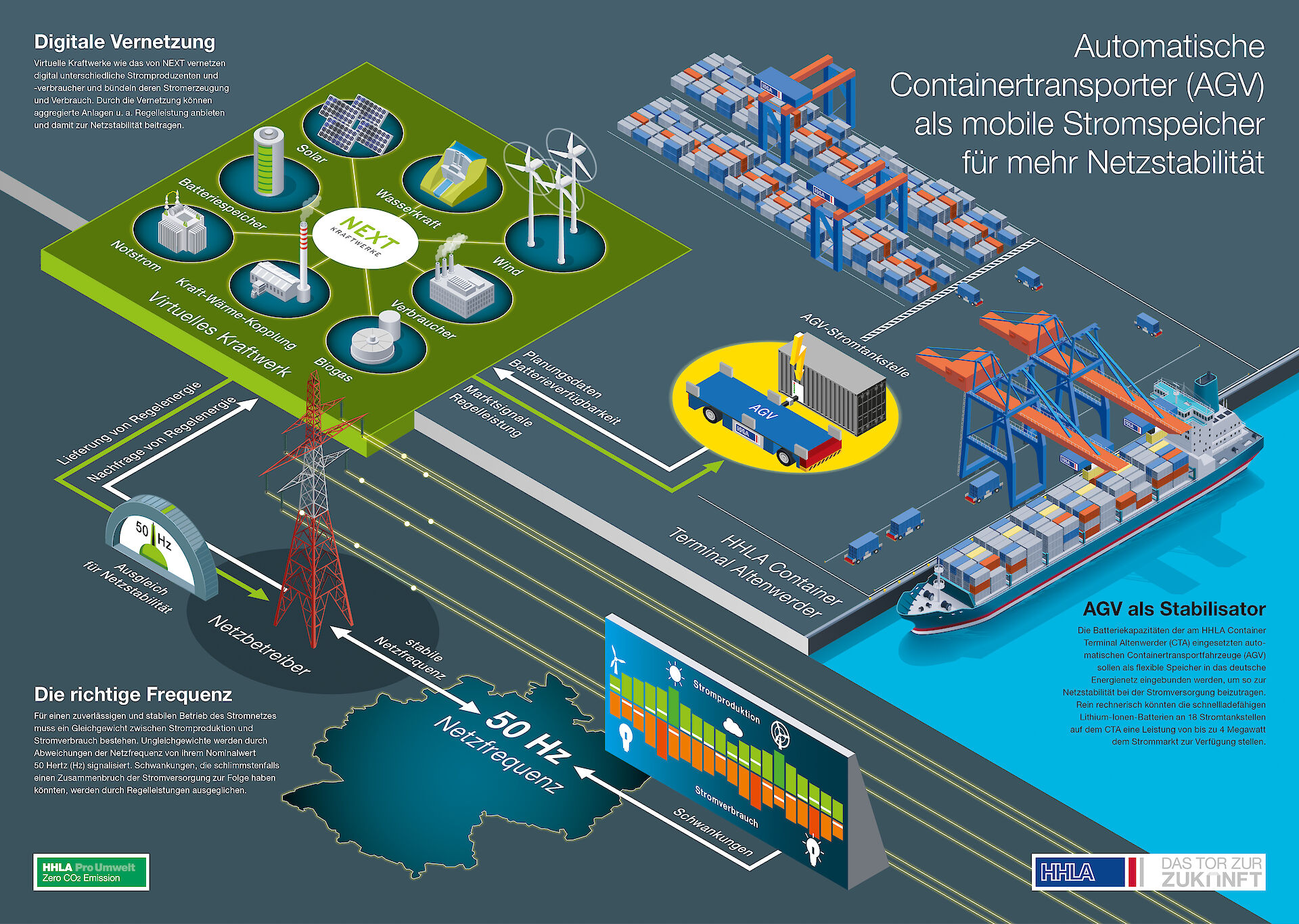

06 Feb 2019 10:38 Environment
At the start of the new year, Hamburger Hafen und Logistik AG (HHLA) and its partners began research and development work on the publicly funded FRESH project at its Container Terminal Altenwerder (CTA). FRESH stands for flexibility management and control reserve provision of heavy goods vehicles in the harbour. The goal is to integrate the battery capacities of the automated guided container transport vehicles (AGVs) that are in use at CTA into the German energy network as flexible storage units that contribute to the grid stability of the power supply.
One of the greatest challenges of the energy transition in Germany is the safeguarding of grid stability. By now, the share of renewable energy sources in the German electricity mix is more than 40 percent. This development requires technical solutions by the network providers so that companies and private consumers may soundly be supplied with electricity at all times.
As opposed to power stations driven by fossil fuels, which can provide electricity on demand, this is not guaranteed with renewable energies. Weather dependent energy sources like wind and sun are not always available. This leads to fluctuations that must be absorbed in order to guarantee a consistently secure supply and a stable frequency of 50 hertz (Hz) on the power grid.
An example of what happens when the supply frequency deviates too greatly from the 50 Hz norm was apparent in spring 2018. Small fluctuations a year ago resulted in radio alarms and stove clocks running late. As a result, people all over Europe were late to school and work since the time they assumed was right was actually incorrect. When deviations from the supply frequency are too far from the ideal value, the worst case is a collapse of the power supply – a blackout.
Virtual power plants are intended to offset the fluctuations. They digitally link various energy producers and consumers and bundle the offers and needs of the participants. If, for example, a solar park cannot deliver adequate electricity due to weather conditions, a bioenergy plant will power up energy production at the same time. If the wind is blowing particularly hard, stationary energy storage systems can store the surplus power.
Pioneering work in the field of grid stability
Now, for the first time, Hamburger Hafen und Logistik AG and Next Kraftwerke GmbH, one of the largest virtual power plant operators in Europe, are investigating the extent to which industrially used mobile battery capacities can be connected to the German power grid so that primary control reserves may be rendered for grid stability under economic conditions. Terminal operations may not be impaired by this.
By 2022, the approximately 100 AGVs in use at terminal Altenwerder for the transport of containers will be completely converted to fast-charging lithium-ion batteries. In purely mathematical terms, they could then provide 4 megawatts for the energy market at the 18 electric charging stations.
“This is, of course, not their primary purpose – container transport is. But in less busy times, free AGVs could provide battery capacity as mobile power stores to safeguard grid stability,” says Boris Wulff of the CTA Terminal Development department, who is responsible for the FRESH project at HHLA.
Together with Next Kraftwerke, the OFFIS Institute for Information Technology in Oldenburg and the University of Göttingen, HHLA is developing within the three-year FRESH project a process and software solution for accessing the power market. It will digitally control the demands of the virtual power plant operator and smooth terminal operations.
“Capacity utilisation at the terminal determines whether AGV capacities are free. These in turn depend on such factors as ship schedules, weather and tide conditions, traffic volume and loading cycles of the AGVs,” explains Wulff. All these parameters must be included in order to develop reliable, efficient and, especially, automated processes. “In this way, we can predict quite precisely when and how long AGVs can dock at the electric charging stations, in order to either give or receive energy when the power grid requires it.”
Alexander Krautz, Team Manager of Innovation & Development at Next Kraftwerke: “The digitisation and electrification of the logistics branch – with its high energy consumption and special requirements – represents a challenge for our power system, while at the same time offering new possibilities for optimisation and stabilisation. Together with our FRESH project partners, this is precisely what we want to demonstrate.”
The Container Terminal Altenwerder is one of the most modern and efficient container terminals and is currently being developed into the first zero-emissions terminal in the world. It is simulta-neously a testing ground and laboratory for new technical and environmentally-friendly applica-tions at HHLA. And it is doing so again: at CTA, FRESH is researching market access solutions for mobile energy storage units for the first time in Germany. The final result of the project will also make it possible for other industries with mobile energy storage units to gain access to the en-ergy market – for instance, logistics warehouses with electric forklifts or hospitals that might use electric vehicles for patient care.
FRESH is funded by the German Federal Ministry for Economic Affairs and Energy as part of the “IKT for Electromobility III” technology programme and receives subsidies of approximately € 1.4 million.
HHLA makes substantial contribution to the energy transition
Annette Krüger
Phone: +49-(0)40-3088-3503
Hans-Jörg Heims
Phone: +49-(0)40-3088-3521